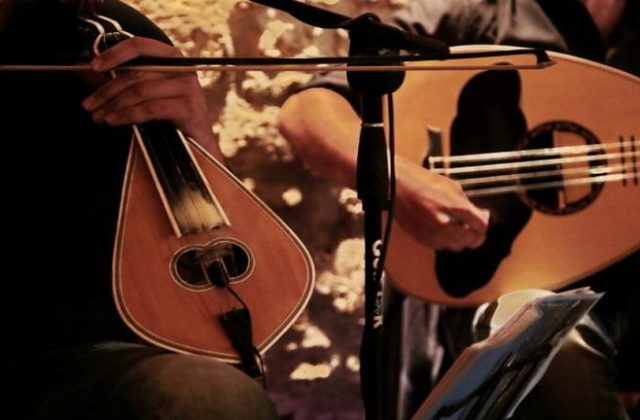Regions of music
The archive makes reference to dozens of places, provinces, cities and villages of Crete where important musicians or singers came into prominence. However, certain of these places left a much deeper imprint on the evolution of the island’s music.

Eastern Crete
This region was dominated by the violin. Stratis Kalogeridis (1883–1960), a musician educated abroad with a unique playing style, creatively processed and assimilated the music he compiled, very old melodies, which he performed with great skill, grace and beauty. He was succeeded by the genius Giannis Dermitzakis (1907–1984) and he, in turn, by Pantelis Baritantonakis. The kondylies (musical phrases) that Baritanonakis plays in the recordings found in the archive are one of the key tunes played on the askomandoura, where the performer uses the violin tries to imitate the timbre and the playing style of the askomandoura. Kondylies originating from Sitia were played all over Lasithi as well as in the Heraklion region. Giannis Dermitzakis also managed to make recordings at the University of Crete two years before he died.
Heraklion: Malevizi, Messara
Malevizi
This northwestern province of the Prefecture of Heraklion gave its name to the maleviziotis, a lively pidichtos (jumping) dance which, in its classical form featuring many well-known turns, is often encountered in Heraklion and Rethymno.
Messara
On the inner plains of southern Crete, in the prefecture of Heraklion and in the wider Heraklion region from Asterousia to the villages of Mount Psiloritis, we find melodies consisting of kondylies from Messara, Ethia and Asterousia, well-known tunes to which the maleviziotis is danced. There are also examples of pidichtos tunes played in mountainous Heraklion, i.e. the foothills of Mount Psiloritis. However, these tunes were also played more slowly in the siganos (kondylies) form, over which mantinades were recited. The characteristic timbre of Messara and mountainous regions of Heraklion can be found in the playing of Konstantinos Spanakis on the mandoura, Michalis Fragkiadakis or Remantonis on the lyra and Lefteris Kambourakis or Kastelolefteris on the bouzouki. Messara and the Heraklion-side of Mount Psiloritis were also home to a peculiar form of the pentozalis or Heraclian pidichtos, as it is called by Foustanis. A similar pidichtos was played on the thiamboli by Manolis Farangoulitakis or Baxes from Voriza, Heraklion. The pediaditikos (plains-type) pidichtos was played in the eastern side of the Heraklion region, in the Pediada area of Heraklion. Its melodies are related to the pidichtos of Malevizi, Sitia and Ierapetra.

Rethymno and Mylopotamos
These regions are the birthplace of the most important Cretan artists: the Xylouris family, Thanasis Skordalos, Kostas Mountakis, Stelios Foustalierakis, Leonidas Klados, Nikos Manias and many others, not to mention giants of the pre-war discography such as Andreas Rodinos, Giannis Bernidakis (Baxevanis) and others. This area is dominated by dances such as the syrtos, slower and faster Rethymno-style pentozalis and sousta. The incomparable playing style of Kostas Mountakis and the existence of a remarkable group of musicians from the wider Mylopotamos area created the unique timbre of the village of Alfa, Mylopotamos, the birthplace of Kostas Mountakis (Mylopotamos-style kondylies and sousta). Moreover, the style in which kondylies are played in Anogia, as noted in an interview given by lyra-player Michalis Melabiotis, strongly influences the musical tradition of the surrounding areas, combined with the concurrent activities of major figures of the Cretan musical tradition.
Western Crete: Chania, Kissamos, Apokoronas
The region of Chania is marked by lively musical movement and corresponding musical and dance peculiarities. The fast pentozalis is played at a much faster tempo than the rest of Crete. There is a wide variety in terms of the name of the syrtos dances found in this Prefecture, deriving from and named after the specific area where each dance is found (e.g. Lusakianos, Sirikarianos, Xerosternianos, Kefalianos, Vafianos, Gavalochorianos, Voulgarianos, Topolianos, Grambousianos, Armenochorianos, Nochianos, etc.). The style and playing of the Chania syrtos dances is the well-established Kissamitiko, or Chaniotiko, or Apokoroniotiko, where the duo of violin and lute or lyra and lute play “straight”, i.e. they emphasise the main beats with down-strokes in a consistent and continuous manner. In Apokoronas, the term “pentozali” or “pentozalia” are used (as is the case in Rethymno) for the tunes of the slow dance, i.e. the musical form known as “kondylies”, a term also encountered in the Prefectures of Heraklion and Lasithi.
In the extremely rich and almost autonomous Kissamos tradition, the violin is the main soloist instrument, but it is played differently than in Lasithi. The area boasts a wealth of very important musicians whose history stretches back to the first steps taken in Cretan traditional music; recordings of some of them, such as Kostis Papadakis (Naftis) and Stelios Lainakis, are included in the archive.

